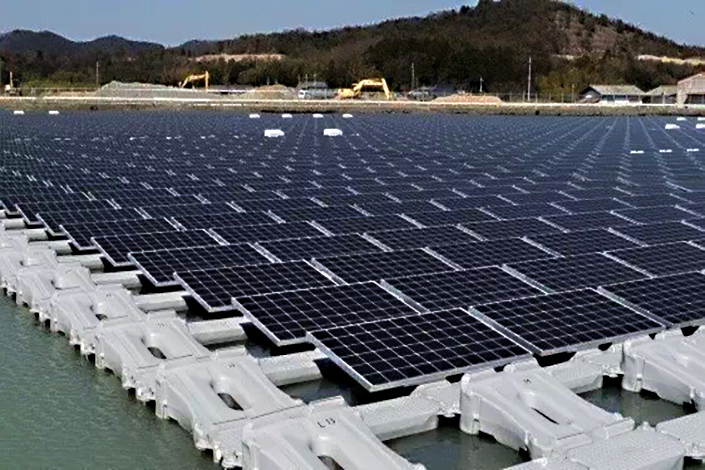Rooftops Power China Solar Boom

(Beijing) — Installations of rooftop photovoltaic solar panels in China almost tripled in the first half of the year, driven by government incentives aimed at boosting the use of renewable energy, government data show.
More than 7 gigawatts (GW) of distributed photovoltaic power was added in the first six months, Xing Yiteng, a deputy head of the New Energy Department of the National Energy Administration (NEA), said at an industry seminar on Wednesday. He said total new installed capacity for this year is likely to exceed 10 GW, which would approach the 12.75 GW of distributed photovoltaic power already installed in China as of the end of March.
Distributed photovoltaic power typically refers to solar panels put on the roof of a residential building, factory or commercial premises, and which generate less than 20 megawatts (MW) of power. It is primarily designed to meet local demand for electricity, as opposed to solar farms that supply power at the utility level to the national grid.
Installation of solar panels by households grew the most rapidly, surging more than seven times in the first half of 2017 from a year earlier, Xing said. Although installation of solar panels is booming in the distributed sector, installed photovoltaic capacity overall in the first half was 24 GW, up only 9%, he said.
That has taken total photovoltaic installed capacity in the country to more than 100GW as of the end of June, close to the target of 105 GW set in the government’s five-year plan for the solar industry, which runs from 2016 to 2020. Xing said the NEA aims to cap total photovoltaic installed capacity at around 150 GW by 2020.
Wasted energy
The boom in distributed photovoltaic installations has been driven by financial incentives as the government encourages growth of distributed generation to meet demand for electricity in the more developed parts of the country and increase the proportion of energy generated from renewable sources.
“The government is encouraging and supporting distributed generation to move more of the renewable energy generation to be at the point of the electricity demand,” said Alex Shoer, who founded Shanghai-based Seeder Clean Energy, a consulting company that helps investors put together distributed generation projects.
Although construction of wind and solar power-generation facilities has increased, especially in the poorer western areas of China, a lot of the energy these farms generate is wasted.
A total of 2.3 billion kilowatt hours of photovoltaic power was “curtailed” in the first quarter of this year, up from 1.9 billion kilowatt hours a year ago, the latest data from the NEA showed. Curtailment happens when generators cannot send the power they produce to the grid for reasons that include insufficient transmission lines or refusal by the operator of the power grid.
China currently faces an oversupply of electricity. There are also technological challenges such as getting power onto the grid and geographical obstacles such as the mismatch between the location of large renewable farms, usually in the remote western parts of the country, and the location of the users, usually in the east.
Shoer said that in 2014 the government started offering a subsidy of 0.42 yuan (6 U.S. cents) for each kilowatt hour of power generated by distributed projects where most of the electricity is consumed onsite.
The government also provides subsidies for solar farms, but has been scaling back the incentives because the program is running short of money. Officials with the National Development and Reform Commission, China’s top economic-planning agency, have said the program had a shortfall of 60 billion yuan by the end of 2016. Companies eligible to receive the subsidies have also complained that they needed to wait at least half a year to get the money.
Risk, return
“For utility-scale projects and distributed projects where electricity is exported to the grid, the feed-in tariff is going down and also there is a longer wait to receive it,” Shoer told Caixin. A feed-in tariff is the on-grid price of solar power that includes a portion of the government subsidy.
“So essentially, there’s more risk and there’s a lower return for the utility-scale and 100% exported projects,” he said, referring to distributed projects that sell all of their power instead of consuming it.
The solar panel industry and building owners are now seeing the distributed sector as a better bet. “The financial returns are what is pushing everyone to move into distributed solar,” Shoer said. “And there is a lot more demand from building owners and factories to have this installed.”
Contact reporter Fran Wang (fangwang@caixin.com)

- 1China Moves to Tighten Air-Quality Standards as Beijing Reports Best-Ever Skies
- 2China Threatens EU After Carbon Border Tax Takes Effect
- 3Gansu Ex-Vice Governor Jailed 15 Years for Bribery, Insider Trading
- 4Cover Story: How Resource Nationalism Is Redrawing the Global Mineral Playbook
- 5 Exclusive: Wingtech Chair Vows to Regain Control of Nexperia After 100-Day Standoff
- 1Power To The People: Pintec Serves A Booming Consumer Class
- 2Largest hotel group in Europe accepts UnionPay
- 3UnionPay mobile QuickPass debuts in Hong Kong
- 4UnionPay International launches premium catering privilege U Dining Collection
- 5UnionPay International’s U Plan has covered over 1600 stores overseas





